Dissociation of State-Selected Ions Studied by Fixed-Photon-Energy Double-Imaging Photoelectron Photoion Coincidence: Cases of O2+ and CH3F+
Abstract
1. Introduction
2. Materials and Methods
3. Dissociation of State-Selected O2+ Ion
3.1. Time-of-Flight Mass Spectrum and Ion Images
3.2. Mass-Selected Electron Images and Photoelectron Spectra
3.3. Electron and Ion Kinetic Energy Correlation Diagrams
4. Dissociation of State-Selected CH3F+ Ion
4.1. Time-of-Flight Mass Spectrum and Ion Images
4.2. Mass-Selected Electron Images and Photoelectron Spectra
4.3. Electron and Ion Kinetic Energy Correlation Diagrams
5. Conclusions
Author Contributions
Funding
Institutional Review Board Statement
Informed Consent Statement
Data Availability Statement
Acknowledgments
Conflicts of Interest
References
- Eland, J.H.D. Photoelectron Spectroscopy: An Introduction to Ultraviolet Photoelectron Spectroscopy in the Gas Phase; Butterworths: London, UK, 1984. [Google Scholar]
- Baer, T.; Hase, W.L. Unimolecular Reaction Dynamics: Theory and Experiments; Oxford University Press: Oxford, UK, 1996. [Google Scholar]
- Ng, C.Y. Vacuum ultraviolet spectroscopy and chemistry by photoionization and photoelectron methods. Annu. Rev. Phys. Chem. 2002, 53, 101–140. [Google Scholar] [CrossRef] [PubMed]
- Qi, F. Combustion chemistry probed by synchrotron VUV photoionization mass spectrometry. Proc. Combust. Inst. 2013, 34, 33–63. [Google Scholar] [CrossRef]
- Kostko, O.; Bandyopadhyay, B.; Ahmed, M. Vacuum ultraviolet photoionization of complex chemical systems. Annu. Rev. Phys. Chem. 2016, 67, 19–40. [Google Scholar] [CrossRef] [PubMed]
- Lafosse, A.; Lebech, M.; Brenot, J.C.; Guyon, P.M.; Jagutzki, O.; Spielberger, L.; Vervloet, M.; Houver, J.C.; Dowek, D. Vector correlations in dissociative photoionization of diatomic molecules in the VUV range: Strong anisotropies in electron emission from spatially oriented NO molecules. Phys. Rev. Lett. 2000, 84, 5987–5990. [Google Scholar] [CrossRef]
- Lebech, M.; Houver, J.C.; Dowek, D. Ion–electron velocity vector correlations in dissociative photoionization of simple molecules using electrostatic lenses. Rev. Sci. Instrum. 2002, 73, 1866–1874. [Google Scholar] [CrossRef]
- Jarvis, G.K.; Weitzel, K.M.; Malow, M.; Baer, T.; Song, Y.; Ng, C.Y. High-resolution pulsed field ionization photoelectron-photoion coincidence spectroscopy using synchrotron radiation. Rev. Sci. Instrum. 1999, 70, 3892–3906. [Google Scholar] [CrossRef]
- Jahnke, T.; Weber, T.; Osipov, T.; Landers, A.L.; Jagutzki, O.; Schmidt, L.P.H.; Cocke, C.L.; Prior, M.H.; Schmidt-Bocking, H.; Dorner, R. Multicoincidence studies of photo and Auger electrons from fixed-in-space molecules using the COLTRIMS technique. J. Electron Spectrosc. Relat. Phenom. 2004, 141, 229–238. [Google Scholar] [CrossRef]
- Eland, J.H.D. Coindence studies of multiionized molecules. In Vacuum Ultraviolet Photoionization and Photodissociation of Molecules and Clusters; Ng, C.Y., Ed.; World Scientific: Singapore, 1991; pp. 297–344. [Google Scholar]
- Eland, J.H.D. Photoelectron-photoion coincidence spectroscopy. I. Basic principles and theory. Int. J. Mass Spectrom. Ion Phys. 1972, 8, 143–151. [Google Scholar] [CrossRef]
- Brechignac, P.; Garcia, G.A.; Falvo, C.; Joblin, C.; Kokkin, D.; Bonnamy, A.; Parneix, P.; Pino, T.; Pirali, O.; Mulas, G.; et al. Photoionization of cold gas phase coronene and its clusters: Autoionization resonances in monomer, dimer, and trimer and electronic structure of monomer cation. J. Chem. Phys. 2014, 141, 164325. [Google Scholar] [CrossRef]
- Chartrand, A.M.; McCormack, E.F.; Jacovella, U.; Holland, D.M.P.; Gans, B.; Tang, X.; Garcia, G.A.; Nahon, L.; Pratt, S.T. Photoelectron angular distributions from rotationally resolved autoionizing states of N2. J. Chem. Phys. 2017, 147, 224303. [Google Scholar] [CrossRef]
- Holland, D.M.P.; Seddon, E.A.; Daly, S.; Alcaraz, C.; Romanzin, C.; Nahon, L.; Garcia, G.A. The effect of autoionization on the N2+ X2Sg+ state vibrationally resolved photoelectron anisotropy parameters and branching ratios. J. Phys. B At. Mol. Opt. Phys. 2013, 46, 095102. [Google Scholar] [CrossRef]
- Baer, T. State selection by photoion-photoelectron coincidence. In Gas Phase Ion Chemistry; Bowers, M.T., Ed.; Academic Press: New York, NY, USA, 1979; Volume 1, pp. 153–196. [Google Scholar]
- Baer, T.; Tuckett, R.P. Advances in threshold photoelectron spectroscopy (TPES) and threshold photoelectron photoion coincidence (TPEPICO). Phys. Chem. Chem. Phys. 2017, 19, 9698–9723. [Google Scholar] [CrossRef] [PubMed]
- Eppink, A.; Parker, D.H. Velocity map imaging of ions and electrons using electrostatic lenses: Application in photoelectron and photofragment ion imaging of molecular oxygen. Rev. Sci. Instrum. 1997, 68, 3477–3484. [Google Scholar] [CrossRef]
- Sztaray, B.; Baer, T. Suppression of hot electrons in threshold photoelectron photoion coincidence spectroscopy using velocity focusing optics. Rev. Sci. Instrum. 2003, 74, 3763–3768. [Google Scholar] [CrossRef]
- Briant, M.; Poisson, L.; Hochlaf, M.; de Pujo, P.; Gaveau, M.-A.; Soep, B. Ar2 Photoelectron Spectroscopy Mediated by Autoionizing States. Phys. Rev. Lett. 2012, 109, 193401. [Google Scholar] [CrossRef]
- Hosaka, K.; Adachi, J.; Golovin, A.V.; Takahashi, M.; Watanabe, N.; Yagishita, A. Coincidence velocity imaging apparatus for study of angular correlations between photoelectrons and photofragments. Jpn. J. Appl. Phys. 2006, 45, 1841–1849. [Google Scholar] [CrossRef]
- Tang, X.; Zhou, X.G.; Niu, M.L.; Liu, S.L.; Sun, J.D.; Shan, X.B.; Liu, F.Y.; Sheng, L.S. A threshold photoelectron-photoion coincidence spectrometer with double velocity imaging using synchrotron radiation. Rev. Sci. Instrum. 2009, 80, 113101. [Google Scholar] [CrossRef]
- Garcia, G.A.; de Miranda, B.K.C.; Tia, M.; Daly, S.; Nahon, L. DELICIOUS III: A multipurpose double imaging particle coincidence spectrometer for gas phase vacuum ultraviolet photodynamics studies. Rev. Sci. Instrum. 2013, 84, 053112. [Google Scholar] [CrossRef]
- Bodi, A.; Hemberger, P.; Gerber, T.; Sztaray, B. A new double imaging velocity focusing coincidence experiment: i2PEPICO. Rev. Sci. Instrum. 2012, 83, 083105. [Google Scholar] [CrossRef]
- Garcia, G.A.; Soldi-Lose, H.; Nahon, L. A versatile electron-ion coincidence spectrometer for photoelectron momentum imaging and threshold spectroscopy on mass selected ions using synchrotron radiation. Rev. Sci. Instrum. 2009, 80, 023102. [Google Scholar] [CrossRef]
- Garcia, G.A.; Tang, X.; Gil, J.F.; Nahon, L.; Ward, M.; Batut, S.; Fittschen, C.; Taatjes, C.A.; Osborn, D.L.; Loison, J.C. Synchrotron-based double imaging photoelectron/photoion coincidence spectroscopy of radicals produced in a flow tube: OH and OD. J. Chem. Phys. 2015, 142, 164201. [Google Scholar] [CrossRef]
- Zhu, Y.; Wu, X.; Tang, X.; Wen, Z.; Liu, F.; Zhou, X.; Zhang, W. Synchrotron threshold photoelectron photoion coincidence spectroscopy of radicals produced in a pyrolysis source: The methyl radical. Chem. Phys. Lett. 2016, 664, 237–241. [Google Scholar] [CrossRef]
- Tang, X.; Lin, X.; Zhu, Y.; Wu, X.; Wen, Z.; Zhang, L.; Liu, F.; Gu, X.; Zhang, W. Pyrolysis of n-butane investigated using synchrotron threshold photoelectron photoion coincidence spectroscopy. RSC Adv. 2017, 7, 28746–28753. [Google Scholar] [CrossRef]
- Sztáray, B.; Voronova, K.; Torma, K.G.; Covert, K.J.; Bodi, A.; Hemberger, P.; Gerber, T.; Osborn, D.L. CRF-PEPICO: Double velocity map imaging photoelectron photoion coincidence spectroscopy for reaction kinetics studies. J. Chem. Phys. 2017, 147, 013944. [Google Scholar] [CrossRef]
- Tang, X.; Gu, X.; Lin, X.; Zhang, W.; Garcia, G.A.; Fittschen, C.; Loison, J.-C.; Voronova, K.; Sztaray, B.; Nahon, L. Vacuum ultraviolet photodynamics of the methyl peroxy radical studied by double imaging photoelectron photoion coincidences. J. Chem. Phys. 2020, 152, 104301. [Google Scholar] [CrossRef]
- Felsmann, D.; Lucassen, A.; Kruger, J.; Hemken, C.; Tran, L.-S.; Pieper, J.; Garcia, G.A.; Brockhinke, A.; Nahon, L.; Kohse-Hoeinghaus, K. Progress in fixed-photon-energy time-efficient double imaging photoelectron/photoion coincidence measurements in quantitative flame analysis. Z. Phys. Chem. 2016, 230, 1067–1097. [Google Scholar] [CrossRef]
- Tang, X.; Garcia, G.A.; Nahon, L. CH3+ formation in the dissociation of energy-selected CH3F+ studied by double imaging electron/ion coincidences. J. Phys. Chem. A 2015, 119, 5942–5950. [Google Scholar] [CrossRef]
- Bodi, A.; Hemberger, P.; Osborn, D.L.; Sztaray, B. Mass-resolved isomer-selective chemical analysis with imaging photoelectron photoion coincidence spectroscopy. J. Phys. Chem. Lett. 2013, 4, 2948–2952. [Google Scholar] [CrossRef]
- Kruger, J.; Garcia, G.A.; Felsmann, D.; Moshammer, K.; Lackner, A.; Brockhinke, A.; Nahon, L.; Kohse-Hoinghaus, K. Photoelectron-photoion coincidence spectroscopy for multiplexed detection of intermediate species in a flame. Phys. Chem. Chem. Phys. 2014, 16, 22791–22804. [Google Scholar] [CrossRef]
- Pieper, J.; Schmitt, S.; Hemken, C.; Davies, E.; Wullenkord, J.; Brockhinke, A.; Krueger, J.; Garcia, G.A.; Nahon, L.; Lucassen, A.; et al. Isomer identification in flames with double imaging photoelectron/photoion coincidence spectroscopy (i2PEPICO) using measured and calculated reference photoelectron spectra. Z. Phys. Chem. 2018, 232, 153–187. [Google Scholar] [CrossRef]
- Fanood, M.M.R.; Ram, N.B.; Lehmann, C.S.; Powis, I.; Janssen, M.H.M. Enantiomer-specific analysis of multi-component mixtures by correlated electron imaging-ion mass spectrometry. Nat. Commun. 2015, 6, 7511. [Google Scholar] [CrossRef] [PubMed]
- Muhlberger, F.; Wieser, J.; Ulrich, A.; Zimmermann, R. Single photon ionization (SPI) via incoherent VUV-excimer light: Robust and compact time-of-flight mass spectrometer for on-line, real-time process gas analysis. Anal. Chem. 2002, 74, 3790–3801. [Google Scholar] [CrossRef] [PubMed]
- Wang, J.S.; Ritterbusch, F.; Dong, X.Z.; Gao, C.; Li, H.; Jiang, W.; Liu, S.Y.; Lu, Z.T.; Wang, W.H.; Yang, G.M.; et al. Optical Excitation and Trapping of 81Kr. Phys. Rev. Lett. 2021, 127, 023201. [Google Scholar] [CrossRef]
- Akahori, T.; Morioka, Y.; Watanabe, M.; Hayaishi, T.; Ito, K.; Nakamura, M. Dissociation processes of O2 in the VUV region 500-700 A. J. Phys. B At. Mol. Opt. Phys. 1985, 18, 2219–2229. [Google Scholar] [CrossRef]
- Richardviard, M.; Dutuit, O.; Lavollee, M.; Govers, T.; Guyon, P.M.; Durup, J. O2+ ions dissociation studied by threshold photoelectron-photoion coincidence method. J. Chem. Phys. 1985, 82, 4054–4063. [Google Scholar] [CrossRef]
- Tang, X.; Zhou, X.G.; Niu, M.L.; Liu, S.L.; Sheng, L.S. Dissociation of vibrational state-selected O2+ ions in the B2Sg state using threshold photoelectron-photoion coincidence velocity imaging. J. Phys. Chem. A 2011, 115, 6339–6346. [Google Scholar] [CrossRef] [PubMed]
- Eland, J.H.D.; Frey, R.; Kuestler, A.; Schulte, H.; Brehm, B. Unimolecular dissociations and internal conversions of methyl halide ions. Int. J. Mass Spectrom. Ion Phys. 1976, 22, 155–170. [Google Scholar] [CrossRef]
- Weitzel, K.M.; Guthe, F.; Mahnert, J.; Locht, R.; Baumgartel, H. Statistical and non-statistical reactions in energy selected fluoromethane ions. Chem. Phys. 1995, 201, 287–298. [Google Scholar] [CrossRef][Green Version]
- Tang, X.; Garcia, G.A.; Nahon, L. Double imaging photoelectron photoion coincidence sheds new light on the dissociation of state-selected CH3F+ ions. J. Phys. Chem. A 2017, 121, 5763–5772. [Google Scholar] [CrossRef]
- Nahon, L.; de Oliveira, N.; Garcia, G.A.; Gil, J.F.; Pilette, B.; Marcouille, O.; Lagarde, B.; Polack, F. DESIRS: A state-of-the-art VUV beamline featuring high resolution and variable polarization for spectroscopy and dichroism at SOLEIL. J. Synchrotron Rad. 2012, 19, 508–520. [Google Scholar] [CrossRef]
- Tang, X.; Garcia, G.A.; Gil, J.-F.; Nahon, L. Vacuum upgrade and enhanced performances of the double imaging electron/ion coincidence end-station at the vacuum ultraviolet beamline DESIRS. Rev. Sci. Instrum. 2015, 86, 123108. [Google Scholar] [CrossRef]
- Bodi, A.; Sztaray, B.; Baer, T.; Johnson, M.; Gerber, T. Data acquisition schemes for continuous two-particle time-of-flight coincidence experiments. Rev. Sci. Instrum. 2007, 78, 084102. [Google Scholar] [CrossRef]
- Garcia, G.A.; Nahon, L.; Powis, I. Two-dimensional charged particle image inversion using a polar basis function expansion. Rev. Sci. Instrum. 2004, 75, 4989–4996. [Google Scholar] [CrossRef]
- Evans, M.; Stimson, S.; Ng, C.Y.; Hsu, C.W.; Jarvis, G.K. Rotationally resolved pulsed field ionization photoelectron study of O2+(B2Sg−, 2Su−; v+ = 0–7) at 20.2–21.3 eV. J. Chem. Phys. 1999, 110, 315. [Google Scholar] [CrossRef]
- Hsu, C.-W.; Heimann, P.; Evans, M.; Stimson, S.; Fenn, P.T.; Ng, C.Y. A high resolution pulsed field ionization photoelectron study of O2 using third generation undulator synchrotron radiation. J. Chem. Phys. 1997, 106, 8931–8934. [Google Scholar] [CrossRef]
- Song, Y.; Evans, M.; Ng, C.Y.; Hsu, C.-W.; Jarvis, G.K. Rotationally resolved pulsed-field ionization photoelectron bands for O2+(A2Pu, v+ = 0–12) in the energy range of 17.0–18.2 eV. J. Chem. Phys. 2000, 112, 1271–1278. [Google Scholar] [CrossRef]
- Nagaraju, S.; Tranter, R.S.; Ardila, F.E.C.; Abid, S.; Lynch, P.T.; Garcia, G.A.; Gil, J.F.; Nahon, L.; Chaumeix, N.; Comandini, A. Pyrolysis of ethanol studied in a new high-repetition-rate shock tube coupled to synchrotron-based double imaging photoelectron/photoion coincidence spectroscopy. Combust. Flame 2021, 226, 53–68. [Google Scholar] [CrossRef]
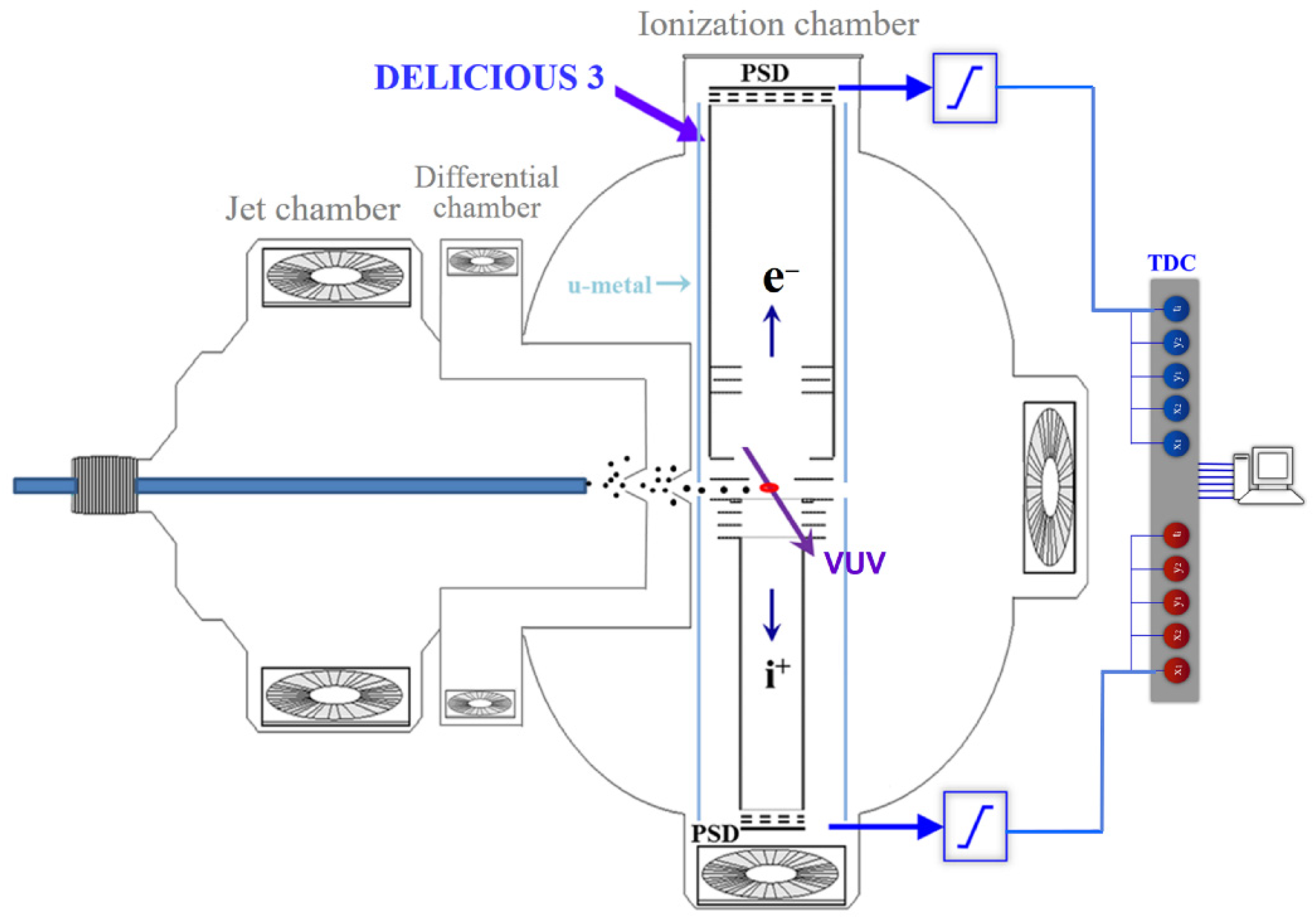

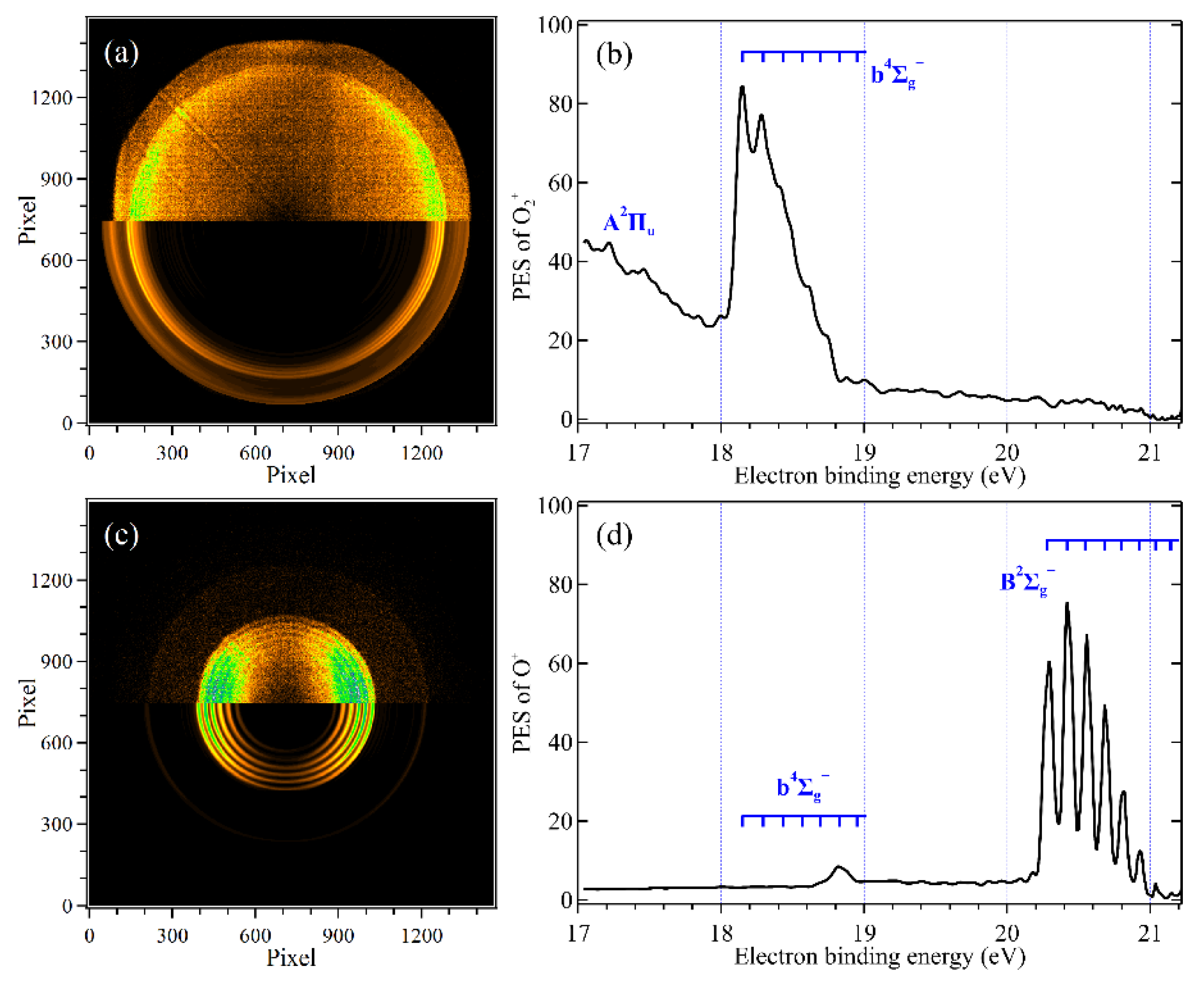
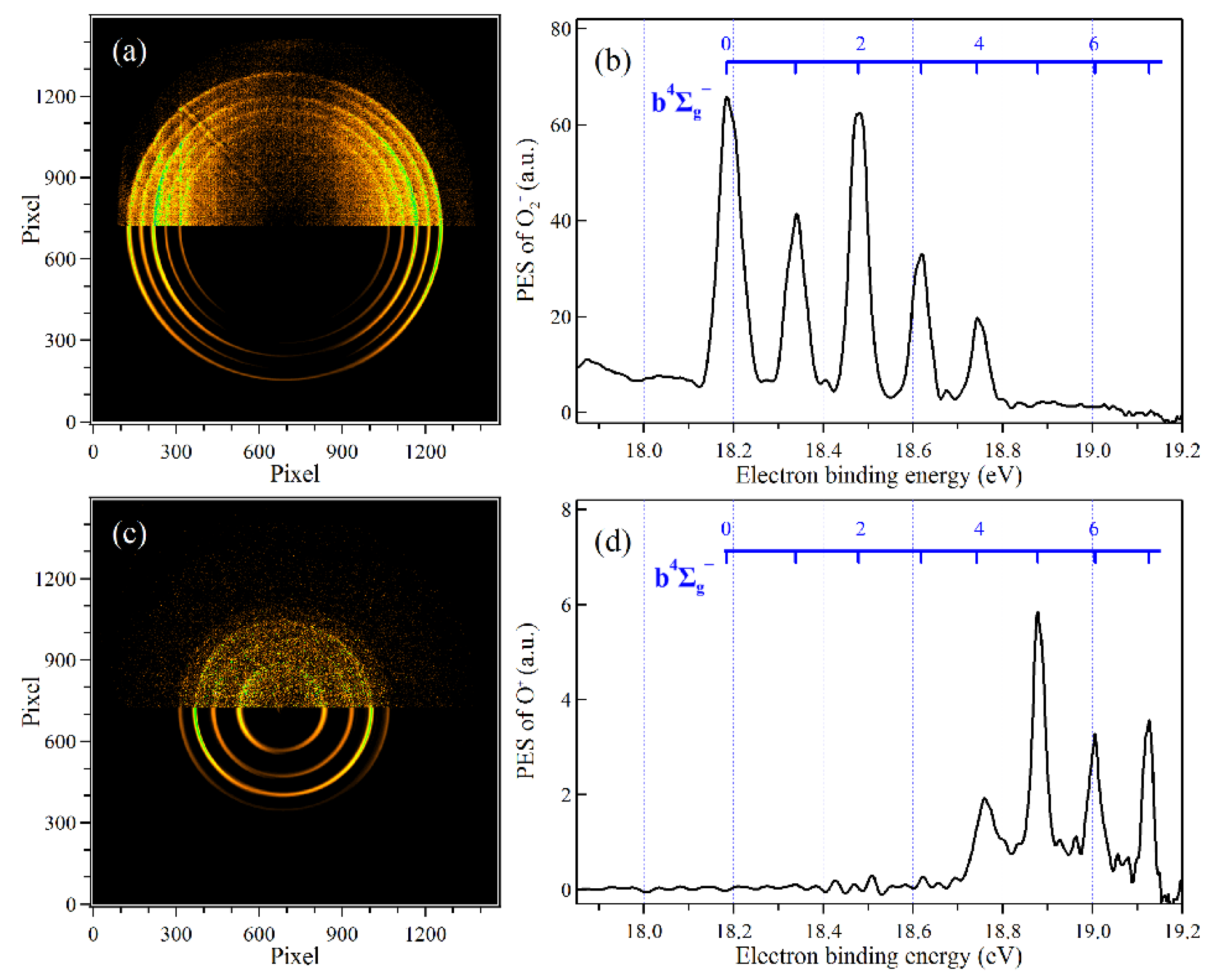
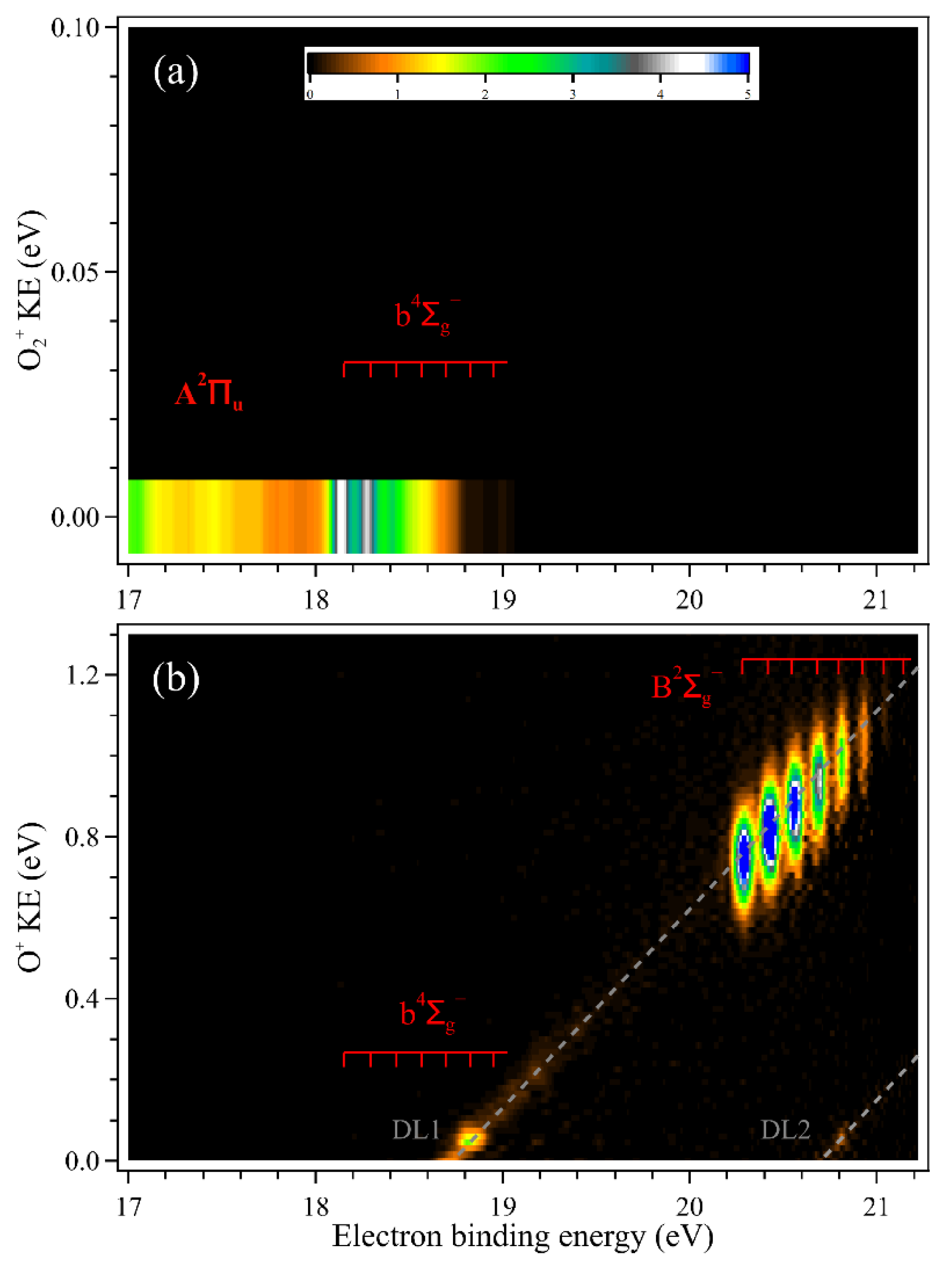

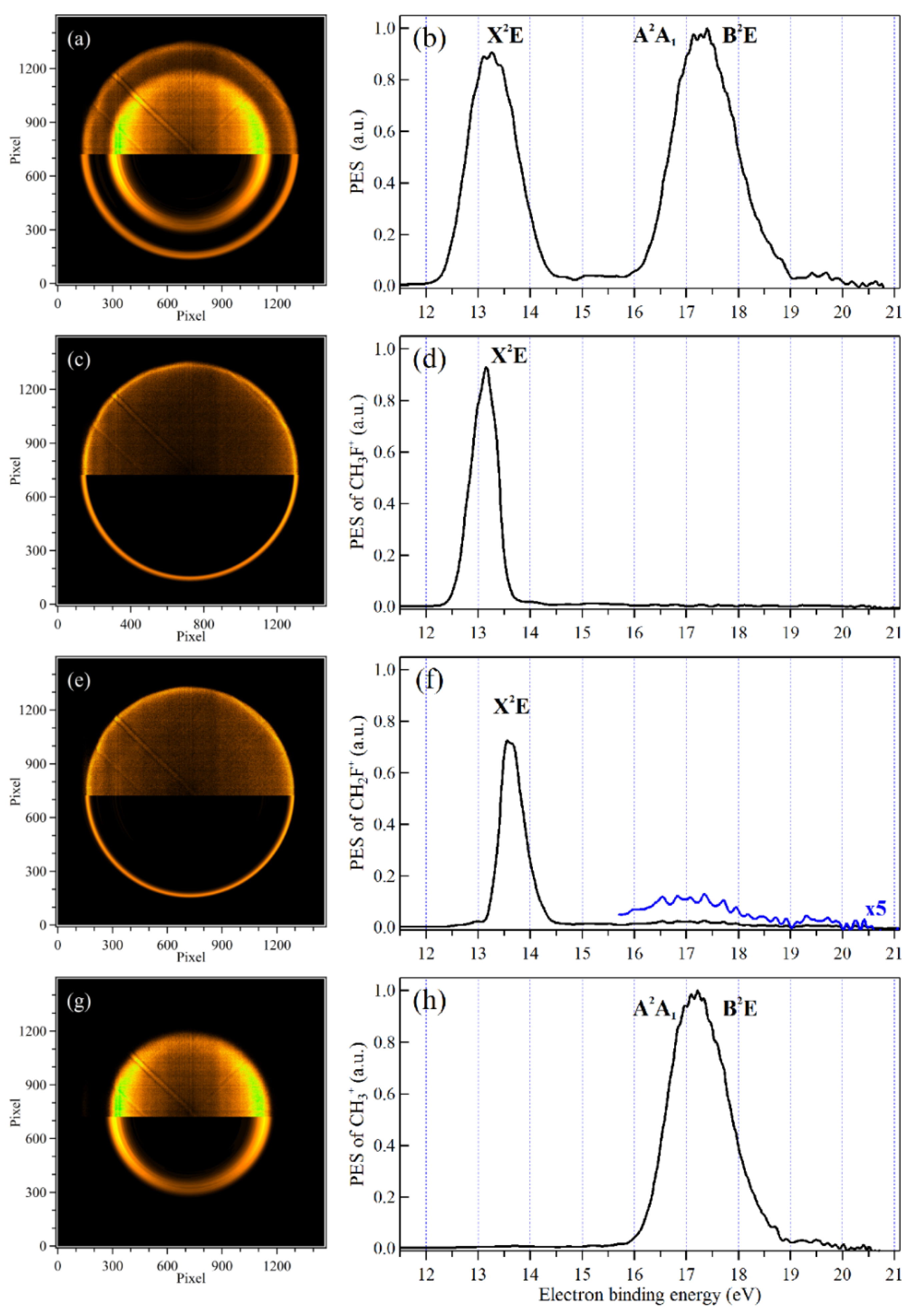

Publisher’s Note: MDPI stays neutral with regard to jurisdictional claims in published maps and institutional affiliations. |
© 2022 by the authors. Licensee MDPI, Basel, Switzerland. This article is an open access article distributed under the terms and conditions of the Creative Commons Attribution (CC BY) license (https://creativecommons.org/licenses/by/4.0/).
Share and Cite
Tang, X.; Garcia, G.A.; Nahon, L. Dissociation of State-Selected Ions Studied by Fixed-Photon-Energy Double-Imaging Photoelectron Photoion Coincidence: Cases of O2+ and CH3F+. Physchem 2022, 2, 261-273. https://doi.org/10.3390/physchem2030019
Tang X, Garcia GA, Nahon L. Dissociation of State-Selected Ions Studied by Fixed-Photon-Energy Double-Imaging Photoelectron Photoion Coincidence: Cases of O2+ and CH3F+. Physchem. 2022; 2(3):261-273. https://doi.org/10.3390/physchem2030019
Chicago/Turabian StyleTang, Xiaofeng, Gustavo A. Garcia, and Laurent Nahon. 2022. "Dissociation of State-Selected Ions Studied by Fixed-Photon-Energy Double-Imaging Photoelectron Photoion Coincidence: Cases of O2+ and CH3F+" Physchem 2, no. 3: 261-273. https://doi.org/10.3390/physchem2030019
APA StyleTang, X., Garcia, G. A., & Nahon, L. (2022). Dissociation of State-Selected Ions Studied by Fixed-Photon-Energy Double-Imaging Photoelectron Photoion Coincidence: Cases of O2+ and CH3F+. Physchem, 2(3), 261-273. https://doi.org/10.3390/physchem2030019





